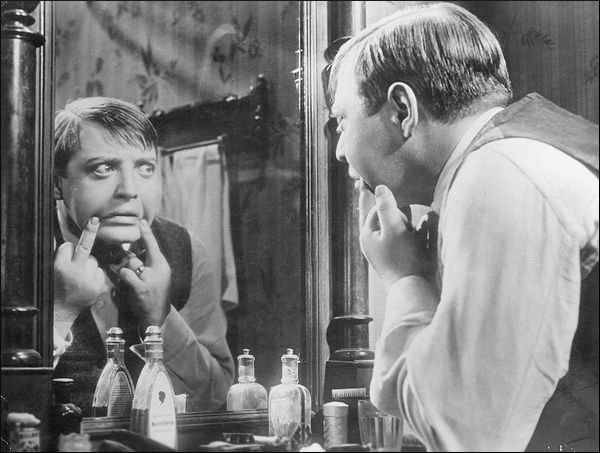M, or M – Eine Stadt sucht ihren Mörder, is the first sound movie by the legendary director Fritz Lang, probably the most influential filmmaker of his time. In fact, M is one of the first German sound movies. It was released in 1931 and, to this day, ranks among the best German films ever made.
The story unfolds in Berlin. One day, little Elsie Beckmann does not return home from school. Instead, she goes off with a phantom-like man who gives her sweets and promises her a balloon. Shortly thereafter, she’s found dead. The police are clueless, even though they receive a letter from the murderer. They analyze the handwriting in order to find out more about the culprit, but without success. Rather, they are overwhelmed by wrong leads and public pressure, and in order to tighten security measures, they look for recently released criminals who have previously done violence against children. Also, they organize raids, which of course are a huge annoyance to the active criminals in the Berlin underworld, since they can't pursue their own business and find it insulting to have been linked to a "beast." They arrange their own search, mobilizing street people like beggars and fellow criminals.
"M is one of the first German sound movies. It was released in 1931 and, to this day, ranks among the best German films ever made."
With this film, Peter Lorre, who plays the murderer Hans Beckert, had his first major starring role. It was his breakthrough, in a career that would lead him to Hollywood in the 40s, 50s, and 60s. But he’s not the only legendary actor featured in this movie. No less a figure than Gustav Gründgens plays the leader of the underworld. He is probably one of the best actors of German origin, and since he was originally a stage actor, M served as his springboard into screenland. The tribunal scene, which features both of these exceptional performers, is breathtakingly intense, even for today’s audience.

The movie has a rich visual language. Its black and white contrasts, its play of shadows, its complete lack of musical arrangements (except for Beckert’s creepy whistling of “In the Hall of the Mountain King,” a composition by Edvard Grieg for Henrik Ibsen’s 1876 play Peer Gynt), its spine-crawling sound effects, its disturbing and distorted camera angles, and its refined cinematography are all the work of a filmic genius who certainly knew his handiwork.
"This variety of dialects is no coincidence: in the 1930s, Berlin was the world’s third biggest city, and many people from different backgrounds came together in this colorful metropolis."
Interestingly, there is no explicit mention of the exact setting. However, several hints suggest that it must be Berlin. What really gives it away is the typical Berlin vernacular of most of the people. Though not very distinct or obvious, we can hear typical Berlin slang words, and the lower the class, the stronger the dialect. For example, in one scene, a local barmaid is talking with a policeman about the devastating effects that the raids have had on local businesses. Her substitution of /g/ with /j/ sounds and her using “det” instead of “das” and “weeß” instead of “weiß” (white), as well as the typical Berlin exclamation “ick doch ooch, Mensch!” (something along the lines of “Well, me too, you know!”), imply that she is from the Spree area. The careful listener will recognize several dialects from other regions, too. There are characters from the Rhine-region as well as the Austro-Bavarian speaking south. Peter Lorre himself has a slight Viennese flavor to his speech, which one can notice even though he talks in High German. This variety of dialects is no coincidence: in the 1930s, Berlin was the world’s third biggest city, and many people from different backgrounds came together in this colorful metropolis.





